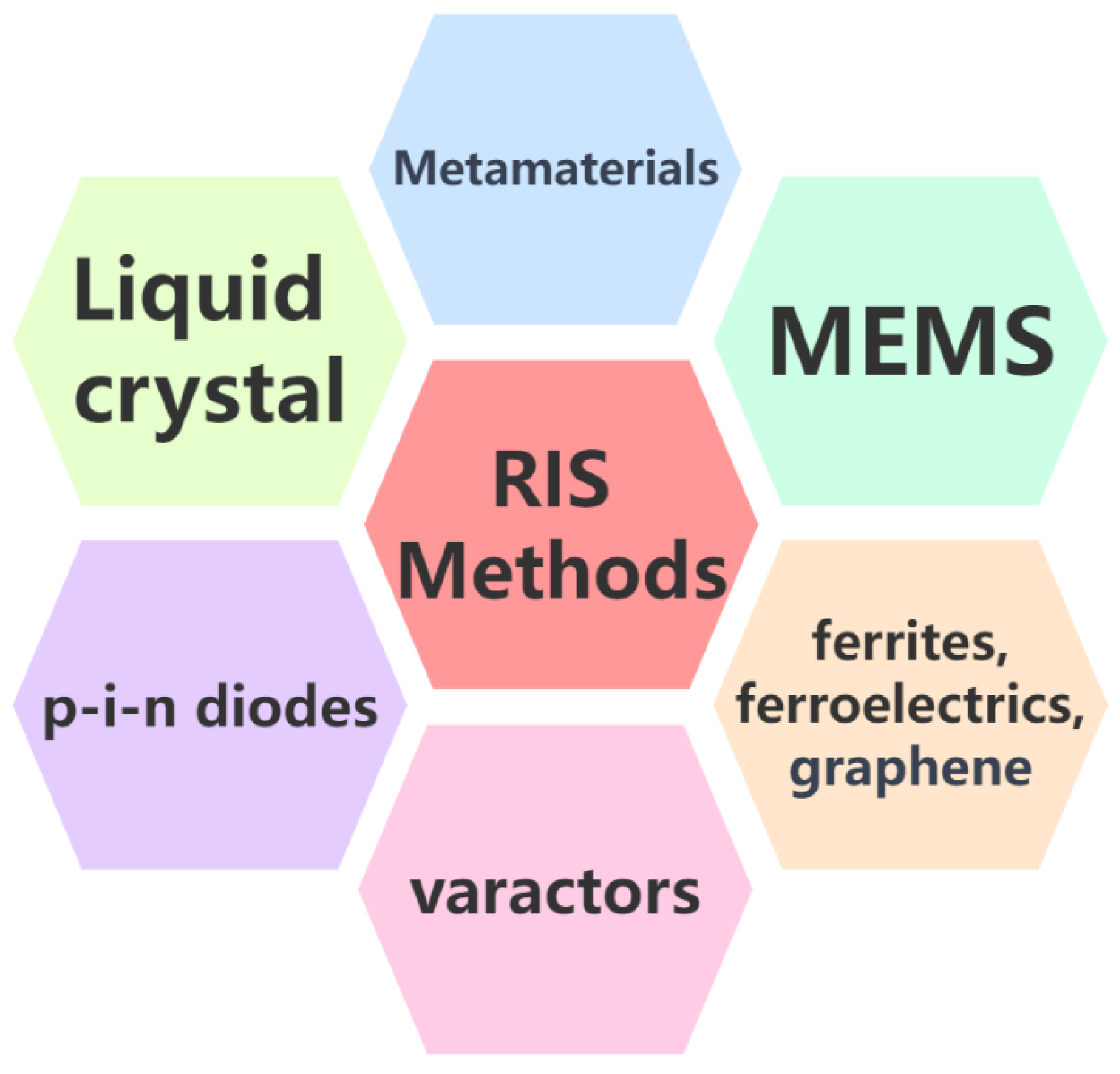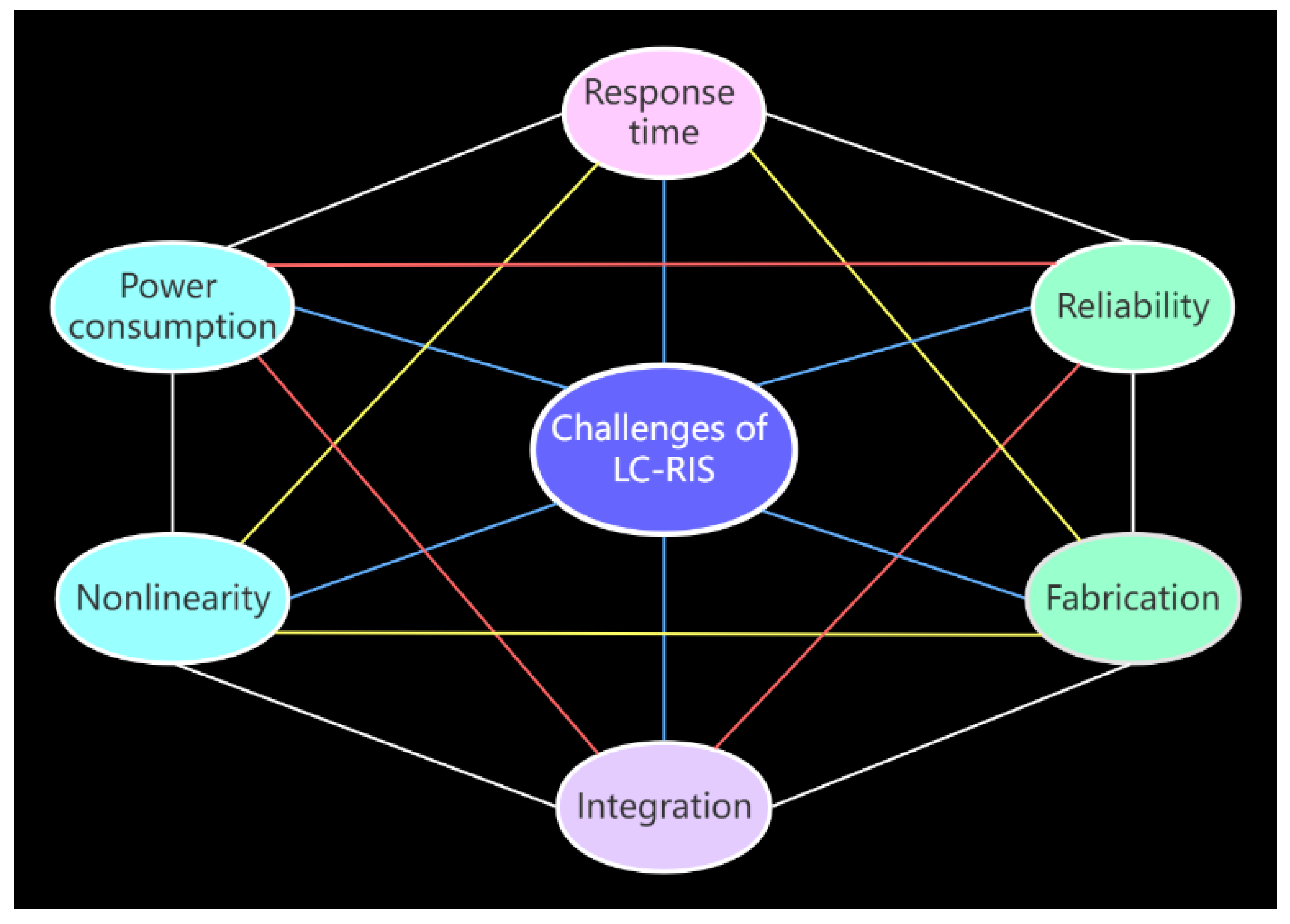From Liquid Crystal on Silicon and Liquid Crystal Reflectarray to Reconfigurable Intelligent Surfaces for Post-5G Networks
Abstract
:1. Introduction
2. Status of RIS and LC-RIS
2.1. Methods to Achieve RIS Inspired by LCRA and LCOS
2.2. Advantages of LC-RIS vs. RIS with Other Methods
3. Challenges of LC-RIS and Future Outlook
4. Development Roadmap of the LC-RIS Industry in China
5. Concluding Remarks
Funding
Institutional Review Board Statement
Informed Consent Statement
Data Availability Statement
Acknowledgments
Conflicts of Interest
References
- Shoaib, N.; Shoaib, S.; Khattak, R.Y.; Shoaib, I.; Chen, X.; Perwaiz, A. MIMO Antennas for Smart 5G Devices. IEEE Access 2018, 6, 77014–77021. [Google Scholar] [CrossRef]
- Almomani, A.; Turjman, F.A. Challenges and Opportunities in Integrated 6G and IoT Paradigms: An Overview. In Proceedings of the 2022 International Conference on Artificial Intelligence in Everything (AIE), Lefkosa, Cyprus, 26 September 2022; pp. 140–145. [Google Scholar]
- Hassan, B.; Baig, S.; Asif, M. Key Technologies for Ultra-Reliable and Low-Latency Communication in 6G. IEEE Commun. Stand. Mag. 2021, 5, 106–113. [Google Scholar] [CrossRef]
- Li, J. Optically Steerable Phased Array Enabling Technology Based on Mesogenic Azobenzene Liquid Crystals for Starlink Towards 6G. In Proceedings of the 2020 IEEE Asia-Pacific Microwave Conference (APMC), Hong Kong, China, 1 February 2021; pp. 345–347. [Google Scholar]
- Filgueiras, H.R.D.; Lima, E.S.; Cunha, M.S.B.; De Souza Lopes, C.H.; De Souza, L.C.; Borges, R.M.; Pereira, L.A.M.; Brandao, T.H.; Andrade, T.P.V.; Alexandre, L.C.; et al. Wireless and Optical Convergent Access Technologies Toward 6G. IEEE Access 2023, 11, 9232–9259. [Google Scholar] [CrossRef]
- Neinavaie, M.; Khalife, J.; Kassas, Z.M. Acquisition, Doppler Tracking, and Positioning with Starlink LEO Satellites: First Results. IEEE Trans. Aerosp. Electron. Syst. 2022, 58, 2606–2610. [Google Scholar] [CrossRef]
- Abdelhady, A.M.; Salem, A.K.S.; Amin, O.; Shihada, B.; Alouini, M.S. Visible Light Communications via Intelligent Reflecting Surfaces: Metasurfaces vs. Mirror Arrays. IEEE Open J. Commun. Soc. 2021, 2, 1–20. [Google Scholar] [CrossRef]
- Björnson, E.; Sanguinetti, L. Power Scaling Laws and Near-Field Behaviors of Massive MIMO and Intelligent Reflecting Surfaces. IEEE Open J. Commun. Soc. 2020, 1, 1306–1324. [Google Scholar] [CrossRef]
- Renzo, M.D.; Debbah, M.; Phan-Huy, D.T.; Zappone, A.; Alouini, M.S.; Yuen, C.; Sciancalepore, V.; Alexandropoulos, G.C.; Hoydis, J.; Gacanin, H.; et al. Smart radio environments empowered by reconfigurable AI meta-surfaces: An idea whose time has come. J. Wirel. Commun. Netw. 2019, 2019, 129. [Google Scholar] [CrossRef] [Green Version]
- Wu, Q.; Zhang, R. Towards Smart and Reconfigurable Environment: Intelligent Reflecting Surface Aided Wireless Network. IEEE Commun. Mag. 2020, 58, 106–112. [Google Scholar] [CrossRef] [Green Version]
- Özdogan, Ö.; Björnson, E.; Larsson, E.G. Intelligent Reflecting Surfaces: Physics, Propagation, and Pathloss Modeling. IEEE Wireless Commun. Lett. 2020, 9, 581–585. [Google Scholar] [CrossRef] [Green Version]
- Di Renzo, M.; Zappone, A.; Debbah, M.; Alouini, M.S.; Yuen, C.; De Rosny, J.; Tretyakov, S. Smart Radio Environments Empowered by Reconfigurable Intelligent Surfaces: How It Works, State of Research, and The Road Ahead. IEEE J. Sel. Areas Commun. 2020, 38, 2450–2525. [Google Scholar] [CrossRef]
- Zeng, S.; Zhang, H.; Di, B.; Tan, Y.; Han, Z.; Poor, H.V.; Song, L. Reconfigurable Intelligent Surfaces in 6G: Reflective, Transmissive, or Both? IEEE Commun. Lett. 2021, 25, 2063–2067. [Google Scholar] [CrossRef]
- Pan, C.; Ren, H.; Wang, K.; Kolb, J.F.; Elkashlan, M.; Chen, M.; Di Renzo, M.; Hao, Y.; Wang, J.; Swindlehurst, A.L.; et al. Reconfigurable Intelligent Surfaces for 6G Systems: Principles, Applications, and Research Directions. IEEE Commun. Mag. 2021, 59, 14–20. [Google Scholar] [CrossRef]
- Marin, R.; Mossinger, A.; Freese, J.; Manabe, A.; Jakoby, R. Realization of 35 GHz steerable reflectarray using highly anisotropic liquid crystal. In Proceedings of the 2006 IEEE Antennas and Propagation Society International Symposium, Albuquerque, NM, USA, 9–14 July 2006; pp. 4307–4310. [Google Scholar]
- McKnight, D.J.; Johnson, K.M.; Serati, R.A. 256 × 256 liquid-crystal-on-silicon spatial light modulator. Appl. Opt. 1994, 33, 2775–2784. [Google Scholar] [CrossRef]
- McKnight, D.J.; Johnson, K.M.; Follett, M.A. Analog distorted helix ferroelectric liquid-crystal-on-silicon spatial light modulator. Opt. Lett. 1995, 20, 513–515. [Google Scholar] [CrossRef] [PubMed]
- Li, J.; Chu, D. Liquid crystal-based enclosed coplanar waveguide phase shifter for 54–66 GHz applications. Crystals 2019, 9, 650. [Google Scholar] [CrossRef] [Green Version]
- Cui, T.J.; Qi, M.Q.; Wan, X.; Zhao, J.; Cheng, Q. Coding metamaterials, digital metamaterials and programmable metamaterials. Light Sci. Appl. 2014, 3, 218. [Google Scholar] [CrossRef] [Green Version]
- Li, J. Rethinking Liquid Crystal Tunable Phase Shifter Design with Inverted Microstrip Lines at 1–67 GHz by Dissipative Loss Analysis. Electronics 2023, 12, 421. [Google Scholar] [CrossRef]
- McManamon, P.F.; Bos, P.J.; Escuti, M.J.; Heikenfeld, J.; Serati, S.; Xie, H.; Watson, E.A. A Review of Phased Array Steering for Narrow-Band Electrooptical Systems. Proc. IEEE 2009, 97, 1078–1096. [Google Scholar] [CrossRef]
- Deo, P.; Syahkal, D.M.; Seddon, L.; Day, S.E.; Fernández, F.A. Beam steering 60 GHz slot antenna array using liquid crystal phase shifter. In Proceedings of the 8th European Conference on Antennas and Propagation (EuCAP 2014), Hague, The Netherlands, 6–11 April 2014; pp. 1005–1007. [Google Scholar]
- Abbasi, M.I.; Ismail, M.Y.; Kamarudin, M.R.; Abbasi, Q.H. Reconfigurable Reflectarray Antenna: A Comparison between Design Using PIN Diodes and Liquid Crystals. Wirel. Commun. Mob. Comput. 2021, 2021, 2835638. [Google Scholar] [CrossRef]
- Meng, X.; Nekovee, M.; Wu, D. The Design and Analysis of Electronically Reconfigurable Liquid Crystal-Based Reflectarray Metasurface for 6G Beamforming, Beamsteering, and Beamsplitting. IEEE Access 2021, 9, 155564–155575. [Google Scholar] [CrossRef]
- Vettese, D. Liquid crystal on silicon. Nat. Photonics 2010, 4, 752–754. [Google Scholar] [CrossRef]
- Wilkinson, T.D. Ferroelectric liquid crystal over silicon devices. Liq. Cryst. Today 2012, 21, 34–41. [Google Scholar] [CrossRef] [Green Version]
- Lazarev, G.; Chen, P.J.; Strauss, J.; Fontaine, N.; Forbes, A. Beyond the display: Phase-only liquid crystal on Silicon devices and their applications in photonics [Invited]. Opt. Express 2019, 27, 16206–716249. [Google Scholar] [CrossRef]
- Wolfe, J.E.; Chipman, R.A. Polarimetric characterization of liquid-crystal-on-silicon panels. Appl. Opt. 2006, 45, 1688–1703. [Google Scholar] [CrossRef]
- Li, J. Challenges and Opportunities for Nematic Liquid Crystals in Radio Frequency and Beyond. Crystals 2022, 12, 632. [Google Scholar] [CrossRef]
- Björnson, E.; Wymeersch, H.; Matthiesen, B.; Popovski, P.; Sanguinetti, L.; Carvalho, E. Reconfigurable Intelligent Surfaces: A signal processing perspective with wireless applications. IEEE Signal Process. Mag. 2022, 39, 135–158. [Google Scholar] [CrossRef]
- Cai, L.; Xu, H.; Li, J.; Chu, D. High FoM liquid crystal based microstrip phase shifter for phased array antennas. In Proceedings of the International Symposium on Antennas and Propagation (ISAP), Okinawa, Japan, 24–28 October 2016; pp. 402–403. [Google Scholar]
- Gumaei, Y.A.A.; Aslam, N.; Chen, X.; Raza, M.; Ansari, R.I. Optimizing Power Allocation in LoRaWAN IoT Applications. IEEE Internet Things J. 2022, 9, 3429–3442. [Google Scholar] [CrossRef]
- Li, J. Wideband PCB-to-Connectors Impedance Adapters for Liquid Crystal-Based Low-Loss Phase Shifters. In Proceedings of the 50th European Microwave Conference (EuMC), Utrecht, The Netherlands, 12–14 January 2021; pp. 546–549. [Google Scholar]
- Li, J. Machine Learning and Digital Twinning Enabled Liquid Crystals mm-Wave Reconfigurable Devices Design and Systems Operation. In Proceedings of the 2022 IEEE MTT-S International Microwave Workshop Series on Advanced Materials and Processes for RF and THz Applications (IMWS-AMP), Guangzhou, China, 13–15 November 2022; pp. 1–3. [Google Scholar]
- Marco, D.; Vargas, A.; López, S.; Moreno, I. Measuring the spatial deformation of a liquid-crystal on silicon display with a self-interference effect. Opt. Lett. 2020, 15, 4480–4483. [Google Scholar] [CrossRef] [PubMed]
- Bouhafs, F.; Hartog, F.; Raschella, A.; Mackay, M.; Shi, Q.; Sinanovic, S. Realizing Physical Layer Security in Large Wireless Networks using Spectrum Programmability. In Proceedings of the 2020 IEEE Globecom Workshops, Taipei, Taiwan, 7–11 December 2020; pp. 1–6. [Google Scholar]
- Huang, Y.; Xiao, T.; Xie, Z.; Zheng, J.; Su, Y.; Chen, W.; Liu, K.; Tang, M.; Zhu, J.; Buschbaum, P.M.; et al. Multistate Nonvolatile Metamirrors with Tunable Optical Chirality. ACS Appl. Mater. Interfaces 2021, 13, 45890–45897. [Google Scholar] [CrossRef]
- Huang, Y.; Xiao, T.; Chen, S.; Xie, Z.; Zheng, J.; Zhu, J.; Su, Y.; Chen, W.; Liu, K.; Tang, M.; et al. All-optical controlled-NOT logic gate achieving directional asymmetric transmission based on metasurface doublet. Opto-Electron. Adv. 2023, 6, 220073. [Google Scholar] [CrossRef]
- Huang, C.; Zhang, C.L.; Yang, J.N.; Sun, B.; Zhao, B.; Luo, X.G. Reconfigurable Metasurface for Multifunctional Control of Electromagnetic Waves. Adv. Opt. Mater. 2017, 5, 1700485. [Google Scholar] [CrossRef]
- Khan, M.U.; Sharawi, M.S.; Mittra, R. Microstrip patch antenna miniaturisation techniques: A review. IET Microw. Antennas Propag. 2015, 9, 913–922. [Google Scholar] [CrossRef]
- Si, L.; Jiang, H.; Lv, X.; Ding, J. Broadband extremely close-spaced 5G MIMO antenna with mutual coupling reduction using metamaterial-inspired superstrate. Opt. Express 2020, 27, 3472–3482. [Google Scholar] [CrossRef]
- Cheng, G.; Si, L.; Tang, P.; Zhuang, Y.; Sun, H.; Ding, J. Topology optimization of the azimuth-rotation-independent polarization conversion metasurface for bandwidth enhancement. Opt. Express 2022, 30, 41340–41349. [Google Scholar] [CrossRef] [PubMed]
- Alamzadeh, I.; Alexandropoulos, G.C.; Shlezinger, N.; Imani, M.F. A reconfigurable intelligent surface with integrated sensing capability. Sci. Rep. 2021, 11, 20737. [Google Scholar] [CrossRef] [PubMed]
- Falahy, N.A.; Alani, O.Y.K. Millimetre wave frequency band as a candidate spectrum for 5G network architecture: A survey. Phys. Commun. 2019, 32, 120–144. [Google Scholar] [CrossRef]
- Stehr, U.; Hagelauer, A.; Hein, M.A. SiCer: Meeting the Challenges of Tomorrow’s Complex Electronic Systems [From the Guest Editors’ Desk]. IEEE Microw. Mag. 2019, 20, 26–92. [Google Scholar] [CrossRef]



| Technology | Phase-Shift Resolution | Power Consumption | Insertion Loss (in GHz) | Response Speed |
|---|---|---|---|---|
| LC phase shifters | Analog tuning (stepless) | Low for transmission line. Moderate for waveguide. | Low for waveguide. Low/moderate for transmission line. | Slow (milliseconds to seconds) |
| Semiconductors and MEMS phase shifters | Digital tuning (binary) | Relatively moderate | High/moderate | |
| Fast (nanoseconds to microseconds) | ||||
| Ferrite and ferroelectric phase shifters | Digital tuning (binary) | Relatively high | High | Moderate (microseconds to milliseconds) |
Disclaimer/Publisher’s Note: The statements, opinions and data contained in all publications are solely those of the individual author(s) and contributor(s) and not of MDPI and/or the editor(s). MDPI and/or the editor(s) disclaim responsibility for any injury to people or property resulting from any ideas, methods, instructions or products referred to in the content. |
© 2023 by the author. Licensee MDPI, Basel, Switzerland. This article is an open access article distributed under the terms and conditions of the Creative Commons Attribution (CC BY) license (https://creativecommons.org/licenses/by/4.0/).
Share and Cite
Li, J. From Liquid Crystal on Silicon and Liquid Crystal Reflectarray to Reconfigurable Intelligent Surfaces for Post-5G Networks. Appl. Sci. 2023, 13, 7407. https://doi.org/10.3390/app13137407
Li J. From Liquid Crystal on Silicon and Liquid Crystal Reflectarray to Reconfigurable Intelligent Surfaces for Post-5G Networks. Applied Sciences. 2023; 13(13):7407. https://doi.org/10.3390/app13137407
Chicago/Turabian StyleLi, Jinfeng. 2023. "From Liquid Crystal on Silicon and Liquid Crystal Reflectarray to Reconfigurable Intelligent Surfaces for Post-5G Networks" Applied Sciences 13, no. 13: 7407. https://doi.org/10.3390/app13137407
APA StyleLi, J. (2023). From Liquid Crystal on Silicon and Liquid Crystal Reflectarray to Reconfigurable Intelligent Surfaces for Post-5G Networks. Applied Sciences, 13(13), 7407. https://doi.org/10.3390/app13137407





